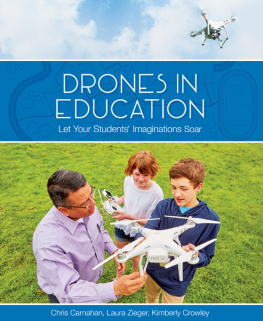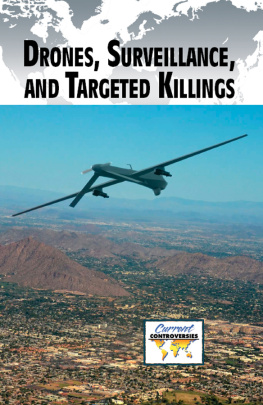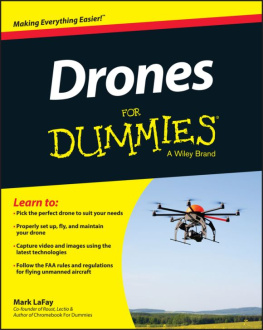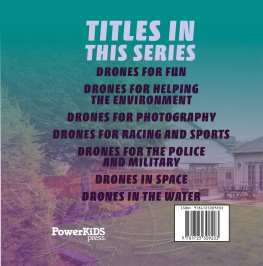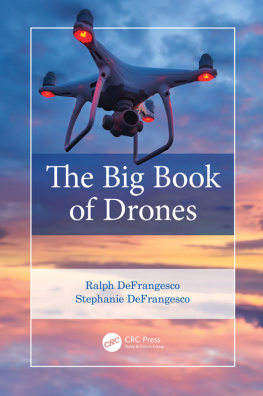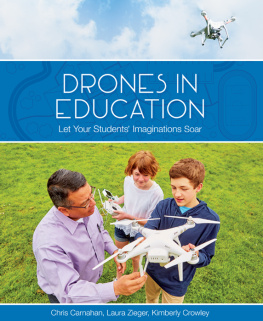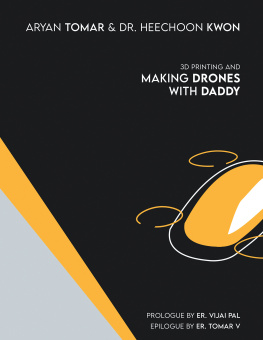
Drones in Education
Let Your Students Imaginations Soar
Christopher Carnahan, Laura Zieger, Kimberly Crowley
2016 International Society for Technology in Education
World rights reserved. No part of this book may be reproduced or transmitted in any form or by any meanselectronic, mechanical, photocopying, recording, or by any information storage or retrieval systemwithout prior written permission from the publisher. Contact Permissions Editor: ; fax: 1.541.302.3780.
Editor: Emily Reed
Production Manager: Christine Longmuir
Copy Editor: Jen Weaver-Neist
Editorial Assistant: Corinne Gould
Book Design and Production: Kim McGovern
Library of Congress Cataloging-in-Publication Data available.
First Edition
ISBN: 978-1-56484-383-8
Ebook version available.
Printed in the United States of America
ISTE is a registered trademark of the International Society for Technology in Education.
About ISTE
The International Society for Technology in Education (ISTE) is the premier nonprofit organization serving educators and education leaders committed to empowering connected learners in a connected world. ISTE serves more than 100,000 education stakeholders throughout the world.
ISTEs innovative offerings include the ISTE Conference & Expo, one of the biggest, most comprehensive ed tech events in the worldas well as the widely adopted ISTE Standards for learning, teaching and leading in the digital age and a robust suite of professional learning resources, including webinars, online courses, consulting services for schools and districts, books, and peer-reviewed journals and publications. Visit iste.org to learn more.
Related ISTE Titles
Getting Started with LEGO Robotics, by Mark Gura
To see all books available from ISTE, please visit iste.org/resources
About the Authors

Christopher Carnahan, PhD is the doctoral program coordinator and assistant professor in the Educational Technology Department at New Jersey City University. His research centers on the implementation of innovative technologies such as drones, robotics, and virtual learning environments to improve student engagement and achievement. Carnahan provides consulting and professional development services to K12 districts on how to successfully implement emerging technologies. His website is www.cdcarnahan.com

Laura Zieger, PhD is the chairperson and a professor in the Department of Educational Technology at New Jersey City University. Her research interests include transformation of learning with emerging technologies including robotics, immersive virtual environments and drones, online teaching, and social computing applications in education. Zieger has published widely and her research and involvement in online parenting communities has been published in Family PC magazine and Sesame Street Parents. She is an invited speaker to schools and organizations.

Kimberly Crowley is mathematics supervisor for a large urban school district in New Jersey. She encourages implementation of STEM and STEAM initiatives within her district. Her goal is to guide administrators and teachers to use technology as part of project-based learning to improve student engagement.
Foreword
From agriculture to logistics and cinematography to workplace management, unmanned autonomous systemsincluding unmanned aerial vehicles (UAVs)are poised to alter the way work is done. These machines represent a sea change in how humans interact with technology. We colloquially refer to them as drones, but they are nothing like the worker bees or weapons of warfare that they may be associated with. It would be more accurate to view them as flying robots that utilize the same engineering principles that have made smart phones ubiquitous.
I have been passionate about drones for many years and as a community leader, visual artist, and STEM instructor, I have found that the power in their potential bridges gaps of age, demography, gender, and occupation. I often refer to myself as an accidental advocate. I didnt set out to become a spokesperson for a cause, but in my role as president of the Drone User Group Network (DUGN), I have advocated for the safe and responsible civilian use of drone technology and have made lifelong affiliations, friends, and colleagues among the 20,000 people (and growing) in our global network. As a photographer and filmmaker, drones scratch an itch that I can only describe as the point where art and science intersect. It is both thrilling and satisfying to operate a drone and understand why and how it functions. I never thought I could get excited about feedback loops or differential equations, but here I am sharing these very concepts with students of all ages in community outreach programs and structured school programs.
Drones are engaging educational tools, as evidenced by their increasing popularity in schools. I have yet to hear a student claim lack of interest when given the opportunity to learn about what drones can do and, more importantly, what they can do with drones. Principles of physics, aeronautics, radio frequency theory, geographical information systems, and lens-based media collection, are all well within the grasp of our students in their exploration of drone technology. The drone is a means to engaging higher learning, and with the information provided in this book, you will be able to capably drones into your instruction and instill your students with a passion for emerging technologies.
Steven Cohen
President Drone User Group Network (dugn.org)
UAS/Mechatronics Instructor
Bergen County Technical Schools
Applied Technology High School
Paramus, NJ
Introduction
You are the coolest teacher in the school!
T hats what you are going to hear when you walk into the classroom. Simply by purchasing this book, you have demonstrated your level of coolness. Who doesnt want to fly an unmanned aircraft with remote video and photographic capabilities? And who wouldnt want to see the wonder on students faces as they fly a drone and apply the concepts learned? The answer is a no-brainer.
This book was written for educators who want to incorporate drones into their curriculum but have no idea where to start. It will cover all that you need to know to get off of the ground (puns are intentional!) with a drone program in your school. It covers such basic but important information as which drones need to be registered and where you can fly them. It also provides recommendations as to the drones that are best for specific age levels and subject areas. The information provided here will offer you everything you need to know to start using drones in the classroom.
When incorporating a new cutting-edge technology into any school setting, you need to know whether it is useful. You do not want to undertake the time and expense of incorporating drones if there is not support that they will have an impact on teaching and learning.

